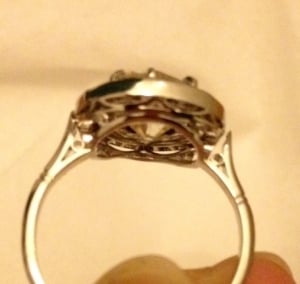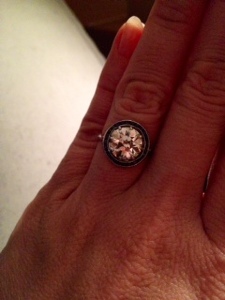Dulcinea
Rough_Rock
- Joined
- Oct 1, 2003
- Messages
- 52
Fellow antique/estate jewelry lovers, I need some help from those of you who have more experience with repairs than I do.
I just got my dream ring back from being resized-- an all-original French Art Deco ring with a ~3ct OEC center and French-cut sapphire "target" surround. About a day after it came back from the sizing, I noticed that the shank had pulled away from the gallery on the right side (see photo). I'm not clear on how this could have happened during a resize, but I'm pretty sure it wasn't like this before.
Honestly, it's not as noticeable in real life as it looks in the close-up pic. I stare at the ring a lot and it did take me a day to notice this. Still, I would prefer that the shank sit flush on the right side just as it does on the left. Problem is, I'm absolutely TERRIFIED of repairs to antique jewelry. I have another antique ring that sustained some serious damage to the head when I had a stone set into it. Granted, that ring is an ornate Edwardian piece, and I think the jeweler was probably using a torch rather than a laser-- but that experience made me gun shy. I would be heartbroken if this ring were botched. I know there's always an element of risk with repairs, and I want to make an educated decision about whether to proceed with the repair or leave well enough alone.
Can I ask your honest opinions? Does this look like a repair that's likely to have serious risks, assuming I choose a bench with as much due diligence as humanly possible?
I just got my dream ring back from being resized-- an all-original French Art Deco ring with a ~3ct OEC center and French-cut sapphire "target" surround. About a day after it came back from the sizing, I noticed that the shank had pulled away from the gallery on the right side (see photo). I'm not clear on how this could have happened during a resize, but I'm pretty sure it wasn't like this before.
Honestly, it's not as noticeable in real life as it looks in the close-up pic. I stare at the ring a lot and it did take me a day to notice this. Still, I would prefer that the shank sit flush on the right side just as it does on the left. Problem is, I'm absolutely TERRIFIED of repairs to antique jewelry. I have another antique ring that sustained some serious damage to the head when I had a stone set into it. Granted, that ring is an ornate Edwardian piece, and I think the jeweler was probably using a torch rather than a laser-- but that experience made me gun shy. I would be heartbroken if this ring were botched. I know there's always an element of risk with repairs, and I want to make an educated decision about whether to proceed with the repair or leave well enough alone.
Can I ask your honest opinions? Does this look like a repair that's likely to have serious risks, assuming I choose a bench with as much due diligence as humanly possible?





300x240.png)